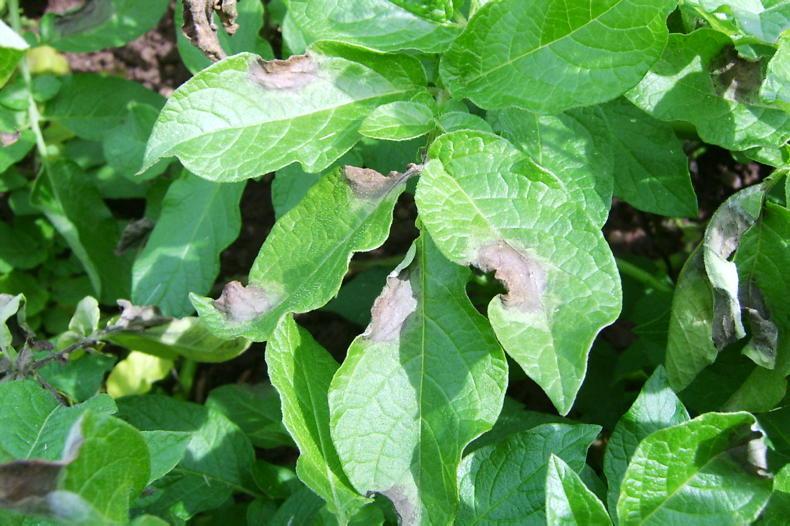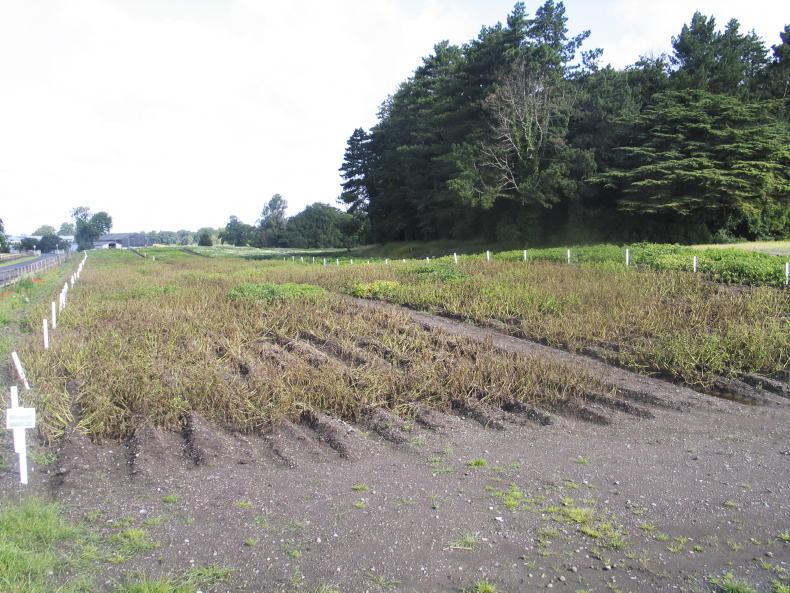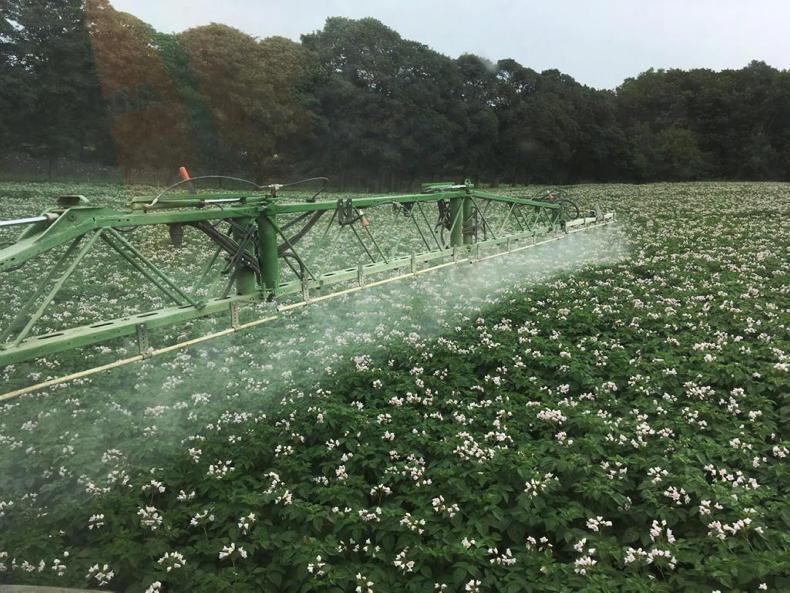Ever since its arrival on our shores over 175 years ago Phytophthora infestans, the pathogen that causes potato late blight, has been synonymous with potato growing.
With an ability to complete its lifecycle in under four days, it truly is a destroyer of potato crops.
Even though we now know the minutest detail of this pathogen, it still has the potential to decimate potato crops if given even the smallest of opportunities. Often when we think we have this beast mastered, it comes back at us the hardest and makes us rethink our strategies.
Unlike cereals, where we are extremely reliant on an ever-decreasing arsenal of fungicide chemistries, for quite some time it appeared that we had a suite of fungicides available for late blight control.

Potato blight lesions.
Also, unlike the major cereal diseases such as septoria of wheat or ramularia of barley, for which fungicide anti-resistance strategies have become a key component of control programmes, their appeared little need to emphasise such strategies for late blight control. This was in spite of the fact that potato crops can receive in excess of 15 applications of fungicides yearly.
For these reasons it comes as a bit of a surprise that, in the space of a season, resistance to two of the most relied upon groups of fungicides – the CAAs (most widely represented by Revus) and the OSBPIs (represented by Zorvec) – has been reported. These reports and associated instances of disease control failures in some of the key potato producing regions of Belgium, The Netherlands and northern Germany in 2023 immediately question how robust our late blight control strategies actually are and whether we should be doing something different.
Blight from Europe
What do we know about the Irish P infestans populations and should we be concerned about what happened in continental Europe in 2023?

Potato blight.
To answer the second part of the question first, the simple answer is yes, we should be concerned. From a late blight population perspective what happens that region of Europe will eventually make its way here. It did some 175 years ago, and to be honest, we didn’t ship seeds like we do now back then, which is one source of inoculum.
It must be assumed that the strains that caused problems in continental European fields in 2023 will be present in Irish fields in 2024 or 2025.
The detection of the sample of P infestans belonging to the EU_43_A1 lineage and confirmation of the mutation associated with CAA resistance in fungicide trials at Oak Park in September 2023 confirms that at least some of those strains are already here. The sample detected was unique among 500 samples tested from the Oak Park trial site. It could be just a chance encounter.
From an epidemiological standpoint, a single sample at the end of the season suggests that this specific encounter blew in from outside of the trial site. Did this single strain blow across the English Channel and the Irish Sea, and by pure chance made its way inland to Oak Park?
Even the most optimistic would have to admit that the chances of that are beyond slim.

Potato blight trials at Teagasc Oak Park.
It is most likely that the sample detected in Oak Park came from a more established infection somewhere else in Ireland. Therefore, we must assume that the strains that caused havoc across mainland Europe in 2023 are here or if they were not present in the 2023 crop that they will be at some stage in 2024.
What is the EU_43_A1 linage?
P infestans can reproduce both asexually (without a mate) or sexually (requiring strains of opposite mating types to meet). In different regions of the world, for unknown reasons, P infestans populations are dominated by either one or the other. To date the Irish P infestans population has been dominated by asexual reproduction, leading to the dominance of clonal lineages. This means that the majority of late blight lesions that occur in Irish potato fields are caused by only a handful of specific strains of P infestans.
By examining their genetic fingerprints, we can group these strains together, with those that are identical referred to as a lineage? By assigning codes it makes it easy for us to monitor the movement of the pathogen across regions. As those lineages that dominate in Ireland are likely to have arisen elsewhere, it also provides us with an opportunity to implement control strategies that may be specific to that linage and hence limit their impacts.
But we must also remember, while certain traits can be specific to a lineage, as fungicide resistance is often the result of a single genetic change, it can occur independently, with resistance often found in multiple lineages.
So, while the EU_43_A1 appears to be dominated by CAA resistance, with a certain proportion also now with resistance to Zorvec, it doesn’t exclude the possibility that other lineages will also develop such resistance.
The 2023 potato season will be remembered for multiple reasons, from delayed planting to a smash and grab harvest. Good prices often tint the overall outlook, and one thing that may be missed in a review of 2023 is the difficulties experienced with late blight control.
Starting in early May, reports of really difficult blight were common in early crops. What information we have suggests that this was due to the wet and mild weather conditions of April and early May, and difficulties with actually getting a decent fungicide application window, and not a specific issue with fungicide resistance. As May progressed into June weather conditions picked up considerably, confirming the best fungicide against blight is dry weather.
Delayed application
However, towards the end of June the weather broke and with it, late blight once again became a problem. Thankfully, in most instances where control was suboptimal, an issue with the fungicide programme such as a delayed application, was easily identified. Similar issues were observed elsewhere in Europe. However, the outcomes of disease control were not always the same, and differences in P infestans populations and the fungicide strategies applied made significant differences to the efficacies of disease control programmes.
The greatest differences in efficacies appear to have been between Denmark and the Netherlands, where strains of EU_43_A1 with CAA resistance were present at the start of the season. In Denmark, where the impacts of this had been felt in the 2022 season, the strict mixing and alternating of fungicides with different modes of action (also referred to as FRAC Groups) across the programme meant that even in the extremely late blight conducive 2023 season, limited issues with efficacies were observed in commercial crops.
Contrast
This was in contrast to the Netherlands where a false sense of security due to a relatively dry early June meant growers applied CAA fungicides as solos, and subsequently in combination with Zorvec.
These initial solo CAA applications likely selected for strains of EU_43_A1 resistant to the CAAs. As subsequent applications of Zorvec were in combination with a CAA, it exposed the Zorvec component of the mix, inevitably leading to the development of resistance to it. The comparisons between both regions is the most valuable demonstration of the value of mixing and alternating fungicides.
Do we need to do anything different in 2024?
If you mix and alternate fungicides of different modes of action across your late blight fungicide control programme then continue to do so. If you don’t, start to.
If you don’t actually know if you do or not, find out. It is this simple, fungicides must be mixed and alternated with a different fungicide mode of action. We are fortunate to have a range of fungicide modes of action effective against P infestans, use them all.

Mild temperatures and high rainfall levels mean high blight pressure.
However, for a mixing and alternation strategy to be successful no individual fungicide should be left overly exposed. For this reason a fungicide such as cymoxanil, which is relatively short lived and hasn’t persistence to last between intervals, is not a true mix partner. Yes, it will provide additional control, especially where disease has developed and it has a clear role to play here.
What it will not do is provide protection to the other mode of action. Likewise, for these strategies to be successful, rates of each partner in the mix must be kept high – ask the question, would a reduced rate of application provide control if applied alone? There is no doubt that this is going to place an additional cost on disease control in potatoes. Unfortunately, for those who have had the experience of walking through crops / plots where it has gotten out of control, it is not a disease that we want to have to try to chase.
Ever since its arrival on our shores over 175 years ago Phytophthora infestans, the pathogen that causes potato late blight, has been synonymous with potato growing.
With an ability to complete its lifecycle in under four days, it truly is a destroyer of potato crops.
Even though we now know the minutest detail of this pathogen, it still has the potential to decimate potato crops if given even the smallest of opportunities. Often when we think we have this beast mastered, it comes back at us the hardest and makes us rethink our strategies.
Unlike cereals, where we are extremely reliant on an ever-decreasing arsenal of fungicide chemistries, for quite some time it appeared that we had a suite of fungicides available for late blight control.

Potato blight lesions.
Also, unlike the major cereal diseases such as septoria of wheat or ramularia of barley, for which fungicide anti-resistance strategies have become a key component of control programmes, their appeared little need to emphasise such strategies for late blight control. This was in spite of the fact that potato crops can receive in excess of 15 applications of fungicides yearly.
For these reasons it comes as a bit of a surprise that, in the space of a season, resistance to two of the most relied upon groups of fungicides – the CAAs (most widely represented by Revus) and the OSBPIs (represented by Zorvec) – has been reported. These reports and associated instances of disease control failures in some of the key potato producing regions of Belgium, The Netherlands and northern Germany in 2023 immediately question how robust our late blight control strategies actually are and whether we should be doing something different.
Blight from Europe
What do we know about the Irish P infestans populations and should we be concerned about what happened in continental Europe in 2023?

Potato blight.
To answer the second part of the question first, the simple answer is yes, we should be concerned. From a late blight population perspective what happens that region of Europe will eventually make its way here. It did some 175 years ago, and to be honest, we didn’t ship seeds like we do now back then, which is one source of inoculum.
It must be assumed that the strains that caused problems in continental European fields in 2023 will be present in Irish fields in 2024 or 2025.
The detection of the sample of P infestans belonging to the EU_43_A1 lineage and confirmation of the mutation associated with CAA resistance in fungicide trials at Oak Park in September 2023 confirms that at least some of those strains are already here. The sample detected was unique among 500 samples tested from the Oak Park trial site. It could be just a chance encounter.
From an epidemiological standpoint, a single sample at the end of the season suggests that this specific encounter blew in from outside of the trial site. Did this single strain blow across the English Channel and the Irish Sea, and by pure chance made its way inland to Oak Park?
Even the most optimistic would have to admit that the chances of that are beyond slim.

Potato blight trials at Teagasc Oak Park.
It is most likely that the sample detected in Oak Park came from a more established infection somewhere else in Ireland. Therefore, we must assume that the strains that caused havoc across mainland Europe in 2023 are here or if they were not present in the 2023 crop that they will be at some stage in 2024.
What is the EU_43_A1 linage?
P infestans can reproduce both asexually (without a mate) or sexually (requiring strains of opposite mating types to meet). In different regions of the world, for unknown reasons, P infestans populations are dominated by either one or the other. To date the Irish P infestans population has been dominated by asexual reproduction, leading to the dominance of clonal lineages. This means that the majority of late blight lesions that occur in Irish potato fields are caused by only a handful of specific strains of P infestans.
By examining their genetic fingerprints, we can group these strains together, with those that are identical referred to as a lineage? By assigning codes it makes it easy for us to monitor the movement of the pathogen across regions. As those lineages that dominate in Ireland are likely to have arisen elsewhere, it also provides us with an opportunity to implement control strategies that may be specific to that linage and hence limit their impacts.
But we must also remember, while certain traits can be specific to a lineage, as fungicide resistance is often the result of a single genetic change, it can occur independently, with resistance often found in multiple lineages.
So, while the EU_43_A1 appears to be dominated by CAA resistance, with a certain proportion also now with resistance to Zorvec, it doesn’t exclude the possibility that other lineages will also develop such resistance.
The 2023 potato season will be remembered for multiple reasons, from delayed planting to a smash and grab harvest. Good prices often tint the overall outlook, and one thing that may be missed in a review of 2023 is the difficulties experienced with late blight control.
Starting in early May, reports of really difficult blight were common in early crops. What information we have suggests that this was due to the wet and mild weather conditions of April and early May, and difficulties with actually getting a decent fungicide application window, and not a specific issue with fungicide resistance. As May progressed into June weather conditions picked up considerably, confirming the best fungicide against blight is dry weather.
Delayed application
However, towards the end of June the weather broke and with it, late blight once again became a problem. Thankfully, in most instances where control was suboptimal, an issue with the fungicide programme such as a delayed application, was easily identified. Similar issues were observed elsewhere in Europe. However, the outcomes of disease control were not always the same, and differences in P infestans populations and the fungicide strategies applied made significant differences to the efficacies of disease control programmes.
The greatest differences in efficacies appear to have been between Denmark and the Netherlands, where strains of EU_43_A1 with CAA resistance were present at the start of the season. In Denmark, where the impacts of this had been felt in the 2022 season, the strict mixing and alternating of fungicides with different modes of action (also referred to as FRAC Groups) across the programme meant that even in the extremely late blight conducive 2023 season, limited issues with efficacies were observed in commercial crops.
Contrast
This was in contrast to the Netherlands where a false sense of security due to a relatively dry early June meant growers applied CAA fungicides as solos, and subsequently in combination with Zorvec.
These initial solo CAA applications likely selected for strains of EU_43_A1 resistant to the CAAs. As subsequent applications of Zorvec were in combination with a CAA, it exposed the Zorvec component of the mix, inevitably leading to the development of resistance to it. The comparisons between both regions is the most valuable demonstration of the value of mixing and alternating fungicides.
Do we need to do anything different in 2024?
If you mix and alternate fungicides of different modes of action across your late blight fungicide control programme then continue to do so. If you don’t, start to.
If you don’t actually know if you do or not, find out. It is this simple, fungicides must be mixed and alternated with a different fungicide mode of action. We are fortunate to have a range of fungicide modes of action effective against P infestans, use them all.

Mild temperatures and high rainfall levels mean high blight pressure.
However, for a mixing and alternation strategy to be successful no individual fungicide should be left overly exposed. For this reason a fungicide such as cymoxanil, which is relatively short lived and hasn’t persistence to last between intervals, is not a true mix partner. Yes, it will provide additional control, especially where disease has developed and it has a clear role to play here.
What it will not do is provide protection to the other mode of action. Likewise, for these strategies to be successful, rates of each partner in the mix must be kept high – ask the question, would a reduced rate of application provide control if applied alone? There is no doubt that this is going to place an additional cost on disease control in potatoes. Unfortunately, for those who have had the experience of walking through crops / plots where it has gotten out of control, it is not a disease that we want to have to try to chase.










 This is a subscriber-only article
This is a subscriber-only article










SHARING OPTIONS: